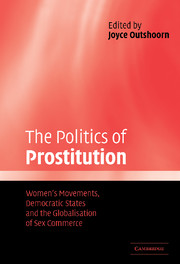 The Politics of Prostitution
The Politics of Prostitution Book contents
- Frontmatter
- Contents
- List of figures
- List of tables
- Notes on contributors
- Preface
- 1 Introduction: prostitution, women's movements and democratic politics
- 2 The women's movement and prostitution politics in Australia
- 3 Taxes, rights and regimentation: discourses on prostitution in Austria
- 4 Prostitution policies in Britain, 1982–2002
- 5 Prostitution as public nuisance: prostitution policy in Canada
- 6 Towards a new prohibitionism? State feminism, women's movements and prostitution policies in Finland
- 7 Prostitute movements face elite apathy and gender-biased universalism in France
- 8 The politics of prostitution and trafficking of women in Israel
- 9 Italy: the never-ending debate
- 10 Voluntary and forced prostitution: the ‘realistic approach’ of the Netherlands
- 11 State feminism and central state debates on prostitution in post-authoritarian Spain
- 12 Criminalising the john – a Swedish gender model?
- 13 The invisible issue: prostitution and trafficking of women and girls in the United States
- 14 Comparative prostitution politics and the case for state feminism
- Appendix 1 Independent variable indicators
- Appendix 2 Worksheets
- References
- Index
6 - Towards a new prohibitionism? State feminism, women's movements and prostitution policies in Finland
Published online by Cambridge University Press: 22 September 2009
- Frontmatter
- Contents
- List of figures
- List of tables
- Notes on contributors
- Preface
- 1 Introduction: prostitution, women's movements and democratic politics
- 2 The women's movement and prostitution politics in Australia
- 3 Taxes, rights and regimentation: discourses on prostitution in Austria
- 4 Prostitution policies in Britain, 1982–2002
- 5 Prostitution as public nuisance: prostitution policy in Canada
- 6 Towards a new prohibitionism? State feminism, women's movements and prostitution policies in Finland
- 7 Prostitute movements face elite apathy and gender-biased universalism in France
- 8 The politics of prostitution and trafficking of women in Israel
- 9 Italy: the never-ending debate
- 10 Voluntary and forced prostitution: the ‘realistic approach’ of the Netherlands
- 11 State feminism and central state debates on prostitution in post-authoritarian Spain
- 12 Criminalising the john – a Swedish gender model?
- 13 The invisible issue: prostitution and trafficking of women and girls in the United States
- 14 Comparative prostitution politics and the case for state feminism
- Appendix 1 Independent variable indicators
- Appendix 2 Worksheets
- References
- Index
Summary
Introduction
By the 1980s, most Finns had begun sincerely to believe that there was no ‘prostitution problem’ at all in the country. This belief was supported by the exceptionally low number of prostitutes nationally (Häkkinen 1995) as well as by the ‘hidden’ forms prostitution had taken in the society (e.g. Varsa 1986). At the turn of the 1990s, however, both day tourism from nearby Russia and Estonia and a domestic recession brought prostitutes back to the streets. The sex industry started to expand in the country, acquiring novel forms (e.g. Näre 1994, 1998; Näre and Lähteenmaa 1995). The prostitution issue made its way back to the political agenda after decades of silence.
By then, Finnish society had tried out many of the most common methods of controlling prostitution. Until 1907, authorities regulated it: prostitutes were licensed and the police were in charge. From 1907 to 1943, the main form of surveillance was medical and aimed at the prevention of venereal diseases (Häkkinen 1995). From 1936 onwards, the Vagrant Act became the major instrument of the newly adopted prohibitionist regime for the next fifty years. This law defined prostitutes as a fourth category of vagrants, i.e. ‘those pursuing a lewd life-style professionally’, who were ‘in the habit of earning their income in indecent and morally deplorable ways’. Prostitutes were put under the control of social workers and, in the last instance, according to a hardening grid of sanctions, sent to institutions of labour.
- Type
- Chapter
- Information
- The Politics of ProstitutionWomen's Movements, Democratic States and the Globalisation of Sex Commerce, pp. 103 - 122Publisher: Cambridge University PressPrint publication year: 2004
- 2
- Cited by


